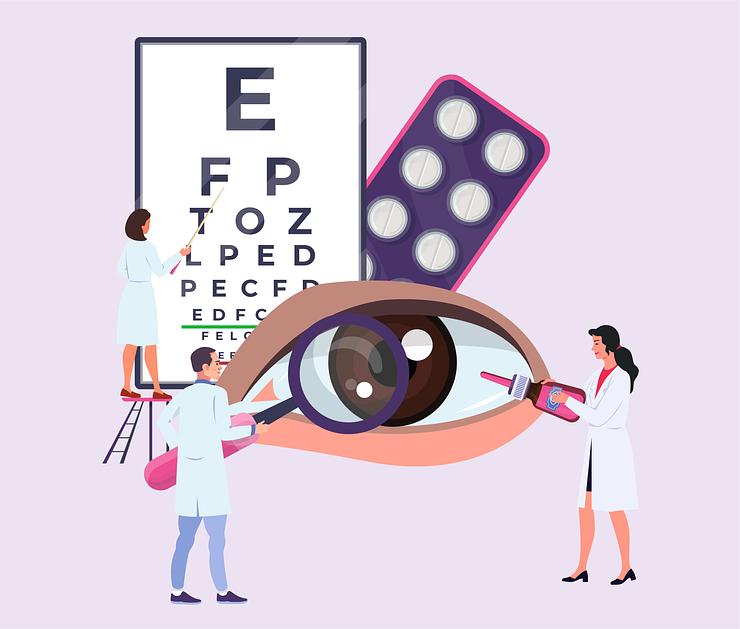Medically reviewed by Dr. Danielle Campbell
From the FYidoctors - Comox Valley
A Complete Guide to Reading and Understanding Your Eye Prescription

How to Understand Your Eye Prescription Easily
Deciphering your eye prescription is simpler than it seems! Each prescription includes specific terms and values that describe how your lenses should be crafted to correct your vision. 'OD' and 'OS' indicate measurements for the right and left eye, respectively. The 'SPH' value shows the lens power needed for distance vision, while 'CYL' and 'Axis' values address astigmatism. 'ADD' numbers are for those needing extra magnification for close work, common in presbyopia. Understanding these elements ensures you get lenses tailored to your vision needs. If any part of the prescription is unclear, your FYidoctors' professional is always ready to help clarify and guide you to the best solutions for your eyesight.
What is an Eye Prescription?
An eye prescription is a written order from your eye doctor that specifies the corrective lenses you need to compensate for the refractive error of your eye. It's like a roadmap for how light should be focused on your retina to produce the clearest possible image.
Your eye doctor determines your prescription during a comprehensive eye exam by:
- Measuring how your eyes focus light using various instruments and tests
- Assessing your visual acuity, or how clearly you can see at different distances
- Evaluating the health of your eyes and checking for any underlying conditions
By identifying the unique way your eyes process light, an eye prescription allows for lenses to be created that refract light precisely, allowing you to see the world in sharp focus. Whether you're nearsighted (myopic), farsighted (hyperopia), or have astigmatism, an accurate prescription is the key to unlocking clear, comfortable vision.
How to Read the Basic Elements of an Eye Prescription
Deciphering your eye prescription starts with understanding the basic elements. Let's break down the key components you'll find on your prescription, starting with the abbreviations for your right and left eye.
What Does 'OD' and 'OS' Mean?
- 'OD' stands for 'oculus dexter,' which is Latin for 'right eye'
- 'OS' stands for 'oculus sinister,' meaning 'left eye'
These abbreviations help distinguish the specific measurements for each eye, as they may differ.
Understanding Sphere (SPH)
The 'Sphere' or 'SPH' value indicates the amount of lens power, measured in diopters (D), needed to correct your vision:
- A minus (-) sign before the number signifies myopia, nearsightedness, meaning you have difficulty seeing distant objects clearly
- A plus (+) sign denotes hyperopia, farsightedness, indicating you have trouble seeing close-up objects clearly
For example, if your prescription reads -2.50 under 'SPH' for your right eye, it means you need a corrective lens with a power of -2.50D to see distant objects clearly with that eye.
Decoding Cylinder and Axis in Prescriptions
If your prescription includes 'CYL' and 'Axis' values, it means you have astigmatism—an asymmetry in your cornea or lens that affects how light focuses on your retina:
- 'CYL' represents the cylinder power, measured in diopters (D), needed to correct astigmatism
- 'Axis' denotes the orientation of the astigmatism correction, measured in degrees from 0 to 180. This value determines the positioning of the cylindrical power on your corrective lens
For example, if your prescription reads 'CYL -1.25' and 'Axis 90' for your left eye, it means you need a cylindrical power of -1.25D at a 90-degree angle to correct your astigmatism in that eye.
What is Added Magnification and Why is it Important?
If you see 'ADD' or 'NV ADD' on your prescription, it indicates the additional magnifying power needed for near vision tasks, like reading or using a smartphone. This added magnification is essential for individuals with presbyopia—an age-related condition that makes it difficult to focus on close objects. Younger individuals may also have an ADD power to help maximize their ability to see near objects. Multifocal lenses, such as progressive lenses, enhanced readers, anti fatigue, readers, bifocals and trifocals incorporate this added magnification in the lower portion of the lens, allowing you to see clearly at multiple distances. Understanding your 'ADD' value helps ensure you get the right corrective lenses for your specific near vision needs.
How Pupillary Distance (PD) Influences Lens Fitting
Pupillary Distance (PD) is the measurement, in millimeters, between the centers of your pupils. This crucial value ensures that your lenses are correctly aligned with your eyes, allowing you to look through the optical center of each lens for optimal vision correction.
An accurate PD measurement is essential because:
- Incorrect PD can cause eye strain, headaches, and blurred vision
- Misaligned lenses may not fully correct your vision, especially in higher prescriptions
- Proper PD ensures a comfortable fit and reduces distortion, particularly in progressive lenses
If you have any questions about your PD or how it affects your eyewear, don't hesitate to consult with your FYidoctors' eye care professional for personalized advice.
Practical Tips for Understanding Your Eye Prescription
When you receive your eye prescription, it's essential to understand what each element means to ensure you get the right lenses for your needs. If you have any questions or concerns about your prescription, don't hesitate to ask your eye care professional for clarification. They are there to help you understand how to read your prescription and make informed decisions about your vision care.
Remember, regular eye exam are crucial for maintaining healthy vision and detecting any potential issues early on. If you notice any changes in your vision or have trouble seeing clearly with your current prescription, schedule an appointment with your FYidoctors' optometrist to discuss your concerns and explore your options.
FAQ
How do you read a vision prescription?
What do the numbers on my eye prescription mean?
What is a normal cyl in an eye prescription?
How do you read an eye prescription report?
What does add 2.50 mean on an eye prescription?
What is considered a strong eye prescription?